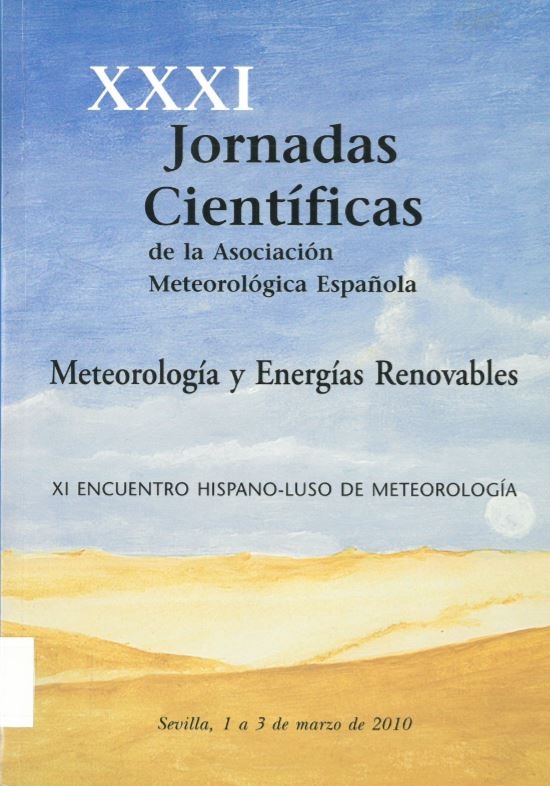UNA RED NEURONAL COMO HERRAMIENTA DE PREDICCIÓN DE VARIABLES CLIMÁTICAS: APLICACIÓN A LA TEMPERATURA MÍNIMA MEDIA MENSUAL EN CASTILLA y LEÓN.
Resumen
Una Red Neuronal Artifical (RNA) del tipo perceptron multicapa (Multilayer Perceptron; MLP) se emplea como base de un modelo local y otro regional para el pronóstico de la variable climática Temperatura mínima media mensual (TminMed). Ambos modelos son alimentados por las series de temperatura mínima media mensual (TminMed) obtenidas en estaciones meteorológicas de la red sinóptica y climatológica de la Agencia Estatal de Meteorología (AEMET) en Castilla y León.La mayor parte de los datos se emplean para entrenar la RNA de tipo MLP y el resto para validar el modelo.
Los resultados obtenidos proporcionan un alto grado de ajuste entre las series reales y las simuladas, tanto en el modelo local como en el modelo regional, lo que confirma la utilidad de esta herramienta en la predicción del comportamiento temporal de variables climáticas. Además el modelo regional mejora ligeramente los resultados obtenidos con el modelo local
Citas
BERTIL T. and MOHSEN S. (2007). Artificial neural network models for indoor temperature prediction: investigations in two buildings. Neural Computing and Applications, 16: 81-89.
CANNON A. J and McKENDRY I. G. (2002). A graphical sensitivity analysis for statistical climate models: application to Indian monsoon rainfall prediction by artificial neural networks and multiple linear regression models. International Journal of Climatology, 22: 1687-1708.
COMRIE, A. C. (1997). Comparing Neural Networks and Regresión Models for Ozone Forecasting. Journal of the Air & Waste Management Association, 47: 653-663.
COTTRELL, M, GIRARD B., GIRARD YVONNE, MANGEAS M. AND MULLER C. (1995) Neural Modelling for Time Series: A Statistical Stepwise Method for Weight Elimination. IEEE transactions on neural networks, 6: 1355-1363.
CURRY B. and MORGAN P.H. (2006) Model selection in Neural Netwoks: Some difficulties. European Journal of Operational Research, 170: 567- 577.
DEMUTH H y BEALE M. (2000). Neural Network Toolbox. User’s Guide. (Version 4). http://www.mathworks.com/access/helpdesk/help/p df_doc/nnet/nnet.pdf.
ISASI VIÑUELA P. y GALVÁN LEÓN I. M. (2004). Redes de neuronas artificiales. Un enfoque práctico. Pearson Educación.
JUHOS I., MAKRA L. and TÓTH B. The behaviour of the multi-layer perceptron and the support vector regression learning methods in the prediction of NO and NO2 concentrations in Szeged, Hungary. (2009). Neural Computing and Applications, 18: 193- 205.
LU T. and VILJANEN M. Prediction of indoor temperature and relative humidity using neural networks models: model comparison. (2009). Neural Computing and Application, 18: 345-357.
MIHALAKAKOU G., SANTAMOURIS M. AND ASIMAKOPOULOS D. Modeling Ambient Air Temperature Time Series Using Neural Networks. . (1998) Journal of Geophysical Research. 103: 19,509-19,517.
NELSON M, HILL T, REMUS W and O’CONNOR M. (1999). Time Series Forecasting Using Neural Networks: Should the Data be Deseasonalized First? Journal of Forecasting, 18: 359-367.
QI M. and ZHANG G. P. (2001). An investigation model selection criteria for neural network time series forecasting. European Journal of Operational Research, 132: 666-680.
ZHANG G. P. and QI M. (2005). Neural network forecasting for seasonal and trend time series. European Journal of Operational Research, 160. 501-514

